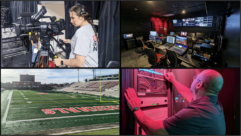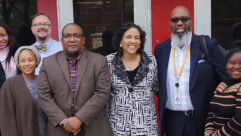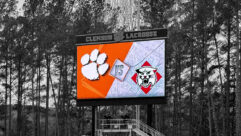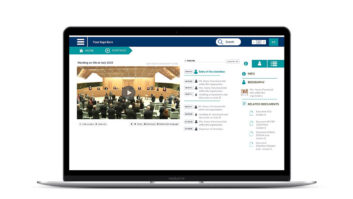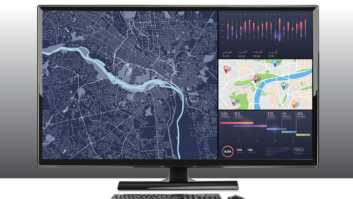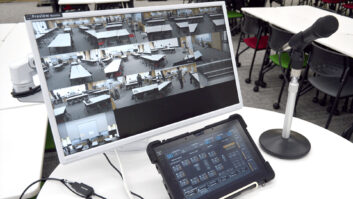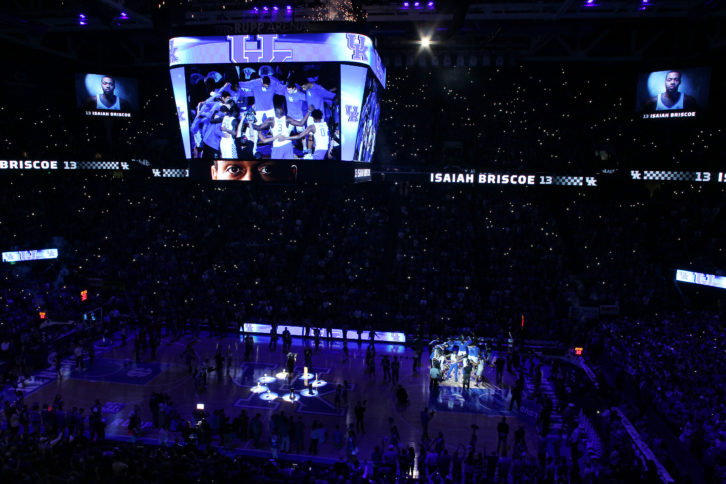
At the University of Kentucky, Lexington they’re serious about their sports and the video coverage reflects that–on the field, in the locker room, in the coverage they serve to ESPN’s SEC Network, as well as on streaming platforms and recruiting platforms. Tim Asher, Director of Athletic Video and Team Technology is here to tell us where the sports video technology has been and where it’s going.
SVC: Can you first describe your job as Director of Athletic Video and Team Technology for UK Athletics?
Tim Asher: I guess they consider me the head bottle washer for anything having to do with technology and video. I’m in charge of 22 teams on our varsity sports, obviously, but also all the stuff that goes on behind the scenes comes under my hat, as well as our production people who are doing our social media and website. All the video production pieces come under my heading. We have a guy who’s in charge of the SEC Network but budgeting-wise everything still comes back through me. So as a long time television person I’m pretty familiar with everything from long lenses for our SEC Network down to the latest and greatest production tools from, let’s say, Blackmagic or any other manufacturer. And then there’s the software and all the other stuff that comes with the team technology side of things. The wearables have become a very big thing now. They’re doing a lot of different tracking with the basketballs and players. They’re doing a lot of different things on a lot of different sports. At times it’s very hard to keep up and it definitely will keep you moving.
You’ve seen some significant video production technologies come and go. Are there one or two that stand out?
My first football game I ever shot was on 16-millimeter film. How about that? The old Arri cameras. I started my career with my hands in a black bag changing out those 400-foot reels. So obviously one of the first things I’d say is the advent of video for the coaching side of things. Betacam made a huge difference. It was so much quicker, so much easier to use. You didn’t have to go through the whole processing part of the scenario and you would actually have stuff usable after the game as opposed to the next day. And then about 1995 or ’96 we got our first Avid Composers in our men’s basketball. We were one of the first three teams in the country to jump onto the non-linear world. That was probably one of the more significant advancements that I’ve seen other than the change from film to video.
In addition to entertaining UK sports fans, you also use some pretty powerful video tools for player recruitment as well.
Non-linear editing made a huge jump for everyone on the basketball and football side. It allowed them to do a whole lot more cutting of tape, to drill down into certain situations. So because of non-linear, the scouting part of video really, really skyrocketed. I started out by myself running a camera, a couple of VHS decks, and a Betacam. And then once the computer came along I was actually doing all the analog stuff as well as a digital copy and was marking that on the fly with a remote. That was the old Firewire days.
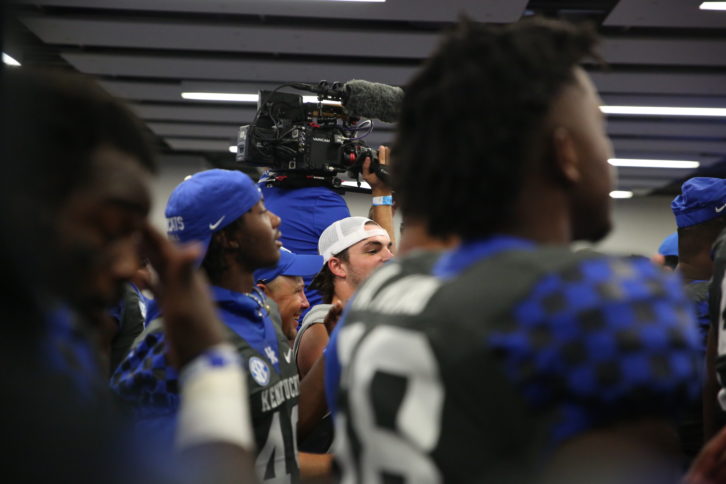
I think you’ve recently made some changes in how you record the games. How have you changed the way you record?
We’re doing a lot of recording now on Matrox Monarch HDX recorders. One of the things I really like about that particular recorder is it allows me to do two different bitrates at the same time. I can put a regular USB drive into it and I can record at three megabits per second on MP4 format, and I can put an SD card in and capture that at 20 megabits per second, which is pretty good quality–enough for TV shows and stuff like that. The three-megabit option comes in so handy; it allows us to exchange files with other teams. It’s small, like about three gigs size-wise. If the other team needs to get the game from me, I can very easily hand them the USB and they can get it very quickly into their system. We also use another technology that is cloud-based. We upload all of our games and exchange them with other teams within the entire NCAA conference. So there are a number of different reasons to do two different bit rates. This Matrox unit allowed me to do two different things with one unit, so it’s a home run in my opinion. It’s one less piece of gear that I have to take on the road. One of the other changes on the production side, is we had been using a lot of the Atmos Ninjas and Shoguns, which do huge files. Now we have gone to the XDCAM recorders and are doing a lot of that stuff with them now. We still use the Ninjas occasionally, and the Shoguns occasionally just depending upon the game. But having a 300-gig file at the end of the game is not a lot of fun quite honestly.
Yeah, for sure.
With the advent of the SEC Network, the technology on probably every campus in our conference has gone up every year. It is kind of an arms race at times. We’re using that technology for recruiting, whether it be in our social media pops, or in our locker room. We recently spent about $4.5 million on our locker room, doing a lot of touchscreen-type monitoring, large Planar monitors over an entire wall. I believe it’s 24 50-inch monitors. And in our locker room itself where the kids get dressed, it’s a round locker room. One of the technologies we’re using in there is the headers on the lockers are actually a video board. We’re using the athletes’ names up there, their Twitter handles, whatever else they might want–their home town, what class they’re in, height, weight, all that kind of stuff–all on the video board. Obviously when a kid comes in he’s seen a locker room before. But he’s probably not seen a round locker room with a video board above each locker before. So you’re trying to have that wow factor with your technology. I think having the SEC Network has driven a lot of that technology even further down into the teams in this conference.
How do you all communicate while the game is going on?
We have the Roameo beltpacks from RTS, and it’s a really strong piece of gear in our arsenal. We have the KP panels at each of our locations in all of our control rooms that also work extremely well with those Roameo units. I think we do a really good job of being able to communicate on headsets and with external people. We have, obviously, a wireless cam that’s running around the stadium trying to get marketing pieces and then they’ll add some color occasionally. We can talk back and forth with that person and ask them to do certain things. We may see something they don’t see. So it’s really nice to have that type of communications. We have two control rooms. We’re in the process of building a third control room for our SEC Network. Most of the SEC Network shows throughout our entire conference are being done on a Ross Carbonite switcher. We’re using Ross routers. We’re, I think, at 128 x 128 in both of our control rooms. So it’s a huge investment for an athletics department to have all this stuff. But as you know, the SEC Network is a huge network. It is very, very helpful to a lot of our programs. Basketball is probably always going to be on the CBS and ESPN, but SEC allowed every football game to be broadcast nationally. It allows the volleyball team, which has become very good here over the last couple of years, to have a lot of national games. Our women’s basketball team is nationally-known, so they get a number of ESPN games throughout the course of the year, but all the rest of the games can be on that SEC Network. Then you have our gymnastics team, which actually made the NCAA tournament and made it down to the Sweet 16. The exposure we were able to get for those girls was incredible because no one had any clue that the team existed before the SEC Network came along. It’s really helpful for our teams and it allows them to then go out and recruit much better athletes.
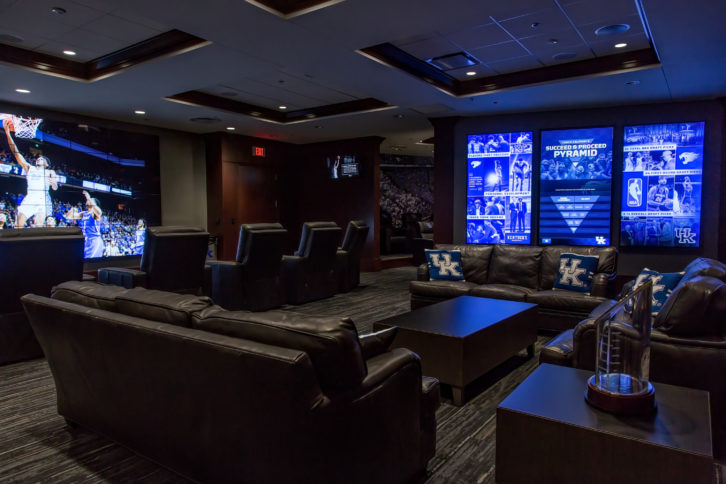
What type of video cameras do you use say, on your truck?
On our trucks and for our SEC Network stuff we’re using Ikegami cameras. And almost all the glass that we have is Canon. We just bought some new Digi 80s and that’s huge. I mean having those big pieces of glass allows you to get those really good close-ups and allows you to get the emotion and everything going on down there on the floor. And obviously everyone knows about an Ike camera. It’s a great camera. On our team side, like for instance our basketball team and our women’s basketball team, we’re using Sony cameras. We’re using some of their smaller X70s, which is a one-chip, one-inch camera. Great image. It’s got an SDI output. We’re using some crazy things because our coaches want to see the time and score even if they’re on a road game. You can’t pick up that time and score generally any other way than taking a second camera and pointing it at the scoreboard. So we’re using a Blackmagic ATEM switcher to do a picture-in-a-picture, basically, on each of those games on the road.
How do you manage to reallocate all of your tech resources as the sports seasons change?
Yeah, that’s a big challenge every year. We’re currently in a situation where the basketball seasons are starting to crank up and at the same time you’re almost a little over halfway through with your football season. Your soccer teams are in their last couple of weeks of their seasons. So you’re taking that equipment that maybe you were using at soccer and then you’ll bring it over to the basketball arena. So it’s a challenge to have, first, enough equipment to cover multiple events at the same time. Everything is being broadcast in some way, shape or form on either the SEC Network, the SEC Plus Network, or they’re being streamed on the SEC Network also. So pretty much every single game on our campus is at least at a minimum being streamed.
That is a lot to reset and reorganize and a lot of equipment being moved around from one venue to another.
Yeah. We’re very fortunate that our athletic director, Mitch Barnhart, gets what we are trying to do and he understands the importance of us spending money for another camera and another lens so that we can have two sports going on at the same time and have both of those telecasts looking like they’re supposed to. Obviously we talked about the glass and how important it is to have really good glass to be able to get those close, tight shots and the emotion that’s actually happening during the event. But audio is something’s that’s huge too. A lot of people, they don’t think about audio a lot, but audio on a broadcast is huge. We spend a lot of time and effort miking different areas of the fields or backboards. Or in football we’re using some Klover Parabolics and stuff like that. The soundboards in both of our control rooms are Soundcraft digital audio boards, 96-input, 24 bus. So obviously we’ve got a lot of audio out there and that’s one of the things that’s probably the hardest moving from one location to another. It never seems like you have enough audio stuff to cover everything that you want to do and everything you want to capture sound-wise.
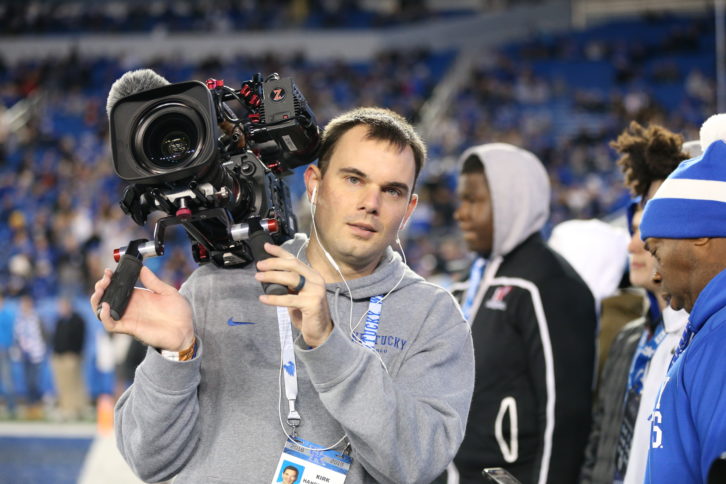
A lot of this is student produced and that ensures some continual turnover. How do you handle the technical training?
We’re doing a lot of things. The SEC Network will probably hire close to 50 students for this school year. Of those they will start some of them out on our videoboard productions so that they can get some training on how to use the cameras and what we’re looking for coverage-wise. It’s a constant training scenario because as you know college students, they change their mind quite a bit. They may love something for one or two games and then they get bored of it and they go away. Then you’ve got to bring another kid in and try to teach them the things that you’re trying to get. So it’s a constant battle. On our production side I think it’s a little easier because we’re normally picking up kids that are in our communications department who already have a bunch of resume-type material that we can go through and see who has potential. It’s funny, we were just talking about audio. That’s one of the hardest positions for finding people. Nobody wants to do audio. Everybody wants to do the video stuff, they want to do the editing stuff, but they don’t want to do the audio and the audio is one of the most important components of the broadcast. Obviously with graphics, and the character generation, that’s another area that you’re constantly having to retrain people. But the student labor aspect of this is huge. We are unusual in that a lot of the schools do internships and stuff like that. We prefer to pay them. They’re getting an hourly wage, so we try to schedule them to come in an hour-and-a-half or so before the games just to make sure everything is good. And then they’ll help us with the teardown. It allows them to get a little money as a college student in their pocket. You try to give them enough hours to where they’ll keep wanting to come back, but some of them don’t. It’s just the nature of the business unfortunately. We do hire a lot of freelancers for our ESPN games and our more high-end stuff where we feel like we need to supplement what we have student-wise. I think most of the people I’ve talked to in our league are doing some of the same thing. They have a core group of kids that they know they can get a certain product out of and will be good for a streaming show. But when you’re going up to the big network then I need better skills here or there. So we pick and choose and try to figure out what people’s strengths and weaknesses are. It’s a constant thing here and it really is amazing the juggling act that we’re able to do over the course of a season.
Where do you handle your studio productions?
Our studio productions are done here in Memorial Coliseum. SEC has what they call a bureau cam, which is a small studio that’s mainly controlled out of Charlotte. There’s a small camera in there, a chair, microphone and they can change the actual backgrounds from Charlotte. They can go from the SEC Network to the ESPN logo or whatever we want to do. So we do a lot of the coaching cuts where they’ll sit down and talk about a game or stuff like that out of those smaller studios. We also have a studio for production. We have a light grid, but I will say that we don’t like to do a whole lot of sit-down interviews in the studio. We like to get people out there in their natural environment and shoot a lot of stuff in that way. We do a lot of our introduction stuff. We may rent an industrial warehouse here in town and get a fog machine and have multiple things going on. It’s not just stick them in front of a green screen or stick them in front of a background type stuff. Our production people are always looking for new and different things to do that keep things engaging.
When you go on the road for your away games, what all is involved in setting up your production gear there and how do you have to accommodate visiting schools, video crews setting up at your home games.
Well the good news is that all of our people in our conference are like a brotherhood, and I truly mean that in every way, shape or form. Yeah, we want to beat them on the field, but at the same time we all know what we’re going through, and if somebody has a problem with a piece of gear or something we’ll step up and help them. I’ve had people step up and help me on the road so I really love that about our conferences. The setup is crazy on the road, I’ll just say that. Because we’re taking multiple cameras. We’ve got a Blackmagic URSA. We’ve got the Arri cameras that I was talking about. We have VariCams. We’re using long lens, we’re using wide-angle lens right in the face in the coaching area. Two hours before a game we’ll get there and we’ll start to unpack our stuff and get everything figured out. It’s a process and people do not realize how much equipment we’re taking on the road with us.
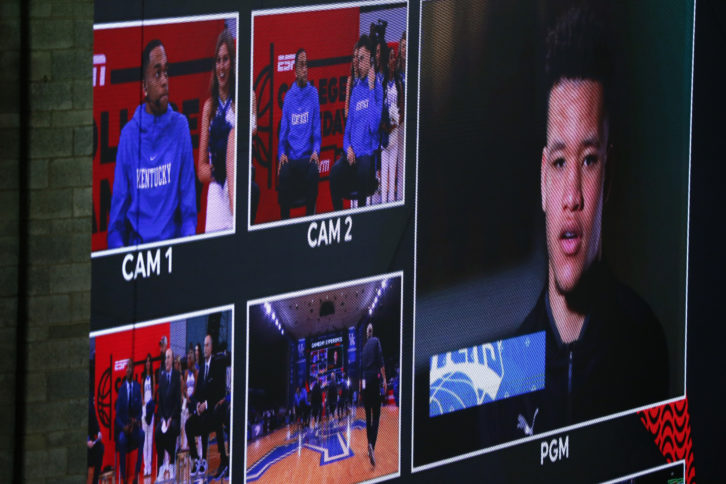
Can you describe the technology competition among SEC schools? They all want bigger scoreboards, production facilities. There’s a lot of money going into this.
Yeah, it’s really crazy. I guess you would say in some ways keeping up with the Joneses, but it’s what you’re trying to do is you’re trying to better your facility. It’s not necessarily trying to keep up with whoever has got the latest and greatest because quite honestly we don’t really do that. Right now we’re looking at our soccer facility, which has an older Daktronics video board in it. And we’re looking to replace that in time for next year’s season. We would like to at least double, probably triple the size of the current one that’s in there. We feel like it’s a little too small. So we’re always looking at how can you improve those facilities and how can you make the fan experience better.
What impact did the formation of the ESPN SEC Network have on the UK Athletics video operation?
Well, it had a huge, huge impact on us. We went from about seven full-time employees to 11 full-time employees. And then our student labor went from approximately 10-12 students up to roughly 75. So the number of people that it takes to do all of the things that we’ve talked about involves a huge amount of resources and it’s constant from the beginning of your season in middle of August right up until the last softball game or baseball game in late May. It doesn’t end. It just goes on and on and on and you have to stay up with it. You have to keep up with all the different pieces of gear and all the moving parts. It’s a challenge, to be quite honest with you, to try and keep up with some of it sometimes. And we’re always trying to help our fans and try to give them a better in-venue experience. One of the things we’ve added for football this year is more stats on our videoboard. So you’re constantly getting feedback from the viewing public and you’re making changes all along based upon some of that and it’s an interesting race, actually.
What sort of tech upgrades are coming down the road for UK Athletics?
Some of the stuff that we’re looking at, obviously, is we’re probably two to three years out for replacement of our videoboards over in our football stadiums. That’s going to be about a $10 million hit, [Laughs] that is about the only way to say that. We’re looking, like I said, at our soccer. We’re also looking right now at our softball. We’ve just upgraded our Memorial Coliseum facility. We have probably the largest indoor board in any of the facilities in our conference right now in that venue. It’s 58-foot wide by 32-foot tall. It’s a huge board in an indoor venue. I know on the production side we’ve actually started looking at some new forms of technology. We’re starting to incorporate NDI technology for press conferences at our football stadium, we’re able to cover those press conferences now without having to send a crew over there all the time. One of the things that we’ve got to try and stay on top of is make sure we have enough bandwidth going forward into the future. I see that as a possible bottleneck and no one wants to talk about bandwidth until you don’t have any, obviously, so it’s hard sometimes for people to realize how important those types of things are.


